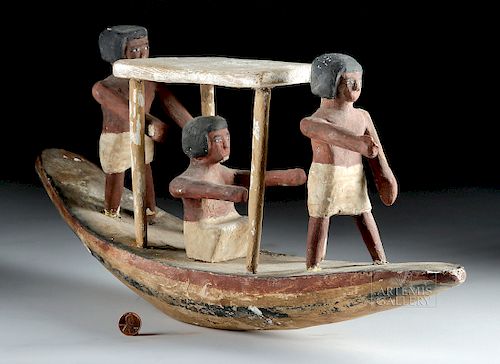Egyptian New Kingdom Wooden Boat & Boatmen
Lot 10
About Seller
Artemis Fine Arts
686 S Taylor Ave, Ste 106
Louisville, CO 80027
United States
Selling antiquities, ancient and ethnographic art online since 1993, Artemis Gallery specializes in Classical Antiquities (Egyptian, Greek, Roman, Near Eastern), Asian, Pre-Columbian, African / Tribal / Oceanographic art. Our extensive inventory includes pottery, stone, metal, wood, glass and textil...Read more
Estimate:
$15,000 - $20,000
Absentee vs Live bid
Two ways to bid:
- Leave a max absentee bid and the platform will bid on your behalf up to your maximum bid during the live auction.
- Bid live during the auction and your bids will be submitted real-time to the auctioneer.
Bid Increments
| Price | Bid Increment |
|---|---|
| $0 | $25 |
| $300 | $50 |
| $1,000 | $100 |
| $2,000 | $250 |
| $5,000 | $500 |
| $10,000 | $1,000 |
| $20,000 | $2,500 |
| $50,000 | $5,000 |
| $100,000 | $10,000 |
| $200,000 | $20,000 |
About Auction
By Artemis Fine Arts
Feb 21, 2019
Set Reminder
2019-02-21 10:00:00
2019-02-21 10:00:00
America/New_York
Bidsquare
Bidsquare : Exceptional Antiquities, Asian, Ethnographic
https://www.bidsquare.com/auctions/artemis-gallery/exceptional-antiquities-asian-ethnographic-3858
An important one-day auction featuring museum-worthy examples of Egyptian, Greek, Roman, Etruscan, Near Eastern, Far East / Asian, Pre-Columbian, African / Tribal, Oceanic, Native American, Spanish Colonial, Russian, Fossils, Ancient Jewelry, Fine Art, so much more! Artemis Fine Arts info@artemisfinearts.com
An important one-day auction featuring museum-worthy examples of Egyptian, Greek, Roman, Etruscan, Near Eastern, Far East / Asian, Pre-Columbian, African / Tribal, Oceanic, Native American, Spanish Colonial, Russian, Fossils, Ancient Jewelry, Fine Art, so much more! Artemis Fine Arts info@artemisfinearts.com
- Lot Description
Ancient Egypt, New Kingdom, ca. 1550 to 1069 BCE. A hand-carved and hand-painted wooden boat with three oarsmen! The men at the front and rear ends of the vessel are standing with their arms extending to row the boat; the man at the front was most likely also a lookout watching for hazards such as sandbars; the gentleman in the center, seated beneath a canopy, was responsible for navigating with steering oars attached to stanchions. All three men present a classic Egyptian visage with large, dark-outlined eyes, a cropped haircut, and a white loincloth. Once carved, the figures and boat were covered in a thin layer of gesso and painted in red, black, cream, and white hues. These boatmen were created to be servants in the afterlife, ready to row the deceased upon the eternal Nile, as real boatmen would have done in life. Size: 19.375" L x 9.625" H (49.2 cm x 24.4 cm)
The funerary boat - customarily decorated with red, white, and black as we see here - is a traditional Egyptian tomb offering created to symbolize the transport of a deceased individual from life to the afterlife. Scholars believe that the Egyptians envisioned death as a journey via boat across the River Nile - the sacred river which ran down the center of the country and was respected as a resource for agriculture, trade, transport, and a symbol of fertility. During the Sixth Dynasty, it became common to place wooden models of lifelike scenes in Egyptian tombs; by the Middle Kingdom, they were placed in the tomb chamber, around the coffin, although some very rich tombs had a separate chamber just for wooden models. Two ships are found in almost all tombs that have models from this time period, and those ships are, during the Middle Kingdom, staffed by boatmen. According to the curatorial team at the MFA Boston, such funerary vessels "made of papyrus bundles lashed together, transported the deceased either to a cemetery across the Nile or to the sanctuary of the god of the afterlife, Osiris, at Abydos. Models of such vessels were painted white with reddish lines representing the bindings." (https://www.mfa.org/collections/object/model-of-a-funerary-boat-143954) As the practice of creating wooden boat models with boatmen continued into the New Kingdom, the numbers continued to increase. In fact, scholars believe that more than 700 figures populated the tomb of Sety I (1294–1279 BCE.
Provenance: ex-private San Francisco, California, USA collection; ex-John Cherones collection, acquired in New York, USA during the 1970s
All items legal to buy/sell under U.S. Statute covering cultural patrimony Code 2600, CHAPTER 14, and are guaranteed to be as described or your money back.
A Certificate of Authenticity will accompany all winning bids.
We ship worldwide and handle all shipping in-house for your convenience.
#144314Boatmen have been reattached. Oars are missing as shown. Expected surface wear to boat and boatmen with losses to pigment and gesso, though much remains. Inactive insect holes and nicks/abrasions here and there as shown.Condition
- Shipping Info
-
All shipping is handled in-house for your convenience. Your invoice from Artemis Gallery will include shipping calculation instructions. If in doubt, please inquire BEFORE bidding for estimated shipping costs for individual items.
-
- Buyer's Premium



 EUR
EUR CAD
CAD AUD
AUD GBP
GBP MXN
MXN HKD
HKD CNY
CNY MYR
MYR SEK
SEK SGD
SGD CHF
CHF THB
THB
















